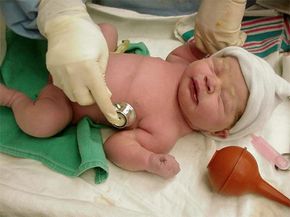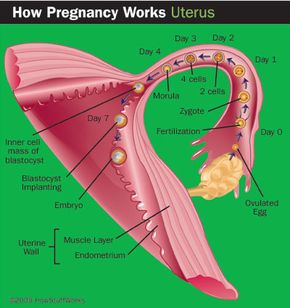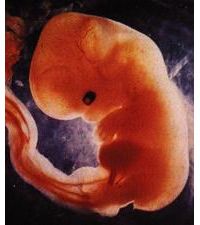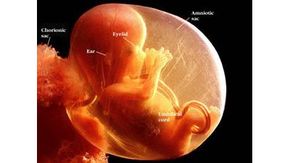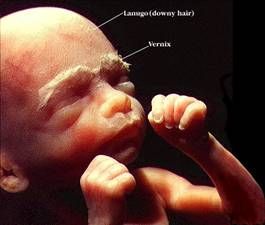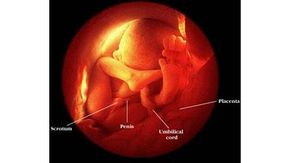During the next 12 weeks, the fetus will finish its development and prepare for the difficult birth process. It is now about 15 inches long and weighs between two and three pounds. Its eyes are a definite color (although they may change after it is born) and are fringed with lashes. Its body is rounding out as fat deposits under its skin. This fat will help its body regulate temperature once it is born. Its brain is becoming larger and more defined, and its skull is growing to accommodate it. If it is a boy, his testicles are descending into his scrotum. If the fetus is a girl, her clitoris is developed.
As the mother's belly swells, she may be in more discomfort, especially near the end of her pregnancy. She might experience hemorrhoids and insomnia. The pressure of the growing uterus on her diaphragm may also make her feel short of breath. It can press down on nerves, causing pain in her lower back and legs, and constrict her bladder, making her run to the bathroom constantly. Many women feel tired and have difficulty sleeping because of their increasing girth.
Sometime during the third trimester, the muscles of the mother's uterus begin contracting. These Braxton-Hicks contractions are practice to help the mother's body prepare for labor. Frequent or painful contractions could be a sign of premature labor.
By week 32, the fetus can move its eyes back and forth and tell the difference between light and dark. It is gaining weight quickly -- about a half pound per week. At this stage in the pregnancy, the fetus weighs just over four pounds and measures 15 to 17 inches long. It may have a full head of hair as well as fingernails and toenails.
The mother's uterus is getting very crowded. Although the fetus continues to move, its movements won't be as fervent as they were earlier in the pregnancy.
At week 35, the fetus measures between 15 and 18 inches long and weighs five-and-a-half to 6 pounds. The lanugo starts to fall off. The vernix caseosa, which protected its body in the amniotic fluid, also disappears. Its organs are almost fully developed.
From this point on, the mother will probably visit her doctor every week until the baby is born. The doctor may do a culture of the mother's vagina to test for bacteria called Group B streptococci, or Group B strep. Mothers who test positive for this bacteria will get intravenous antibiotics during labor to reduce their risk of passing the infection to their baby during labor.
By this point in the pregnancy, the fetus has probably rotated so that it is head down in preparation for birth. Babies that are turned the wrong way are called breech deliveries, but there are ways of turning the baby before labor begins. As her baby drops lower in her pelvis, the mother may feel relief from the breathlessness and other symptoms that have plagued her for the last few weeks.
Although delivery is still a few weeks away, at week 37 the fetus is considered full term. This means that if it were delivered now, it would be able to function outside the womb. It should weigh at least 6 pounds and measure between 19 and 20 inches. At any time between now and the onset of labor, the mucus plug which had blocked the entrance to the mother's cervix to prevent bacteria from entering will come out. This is a sign that labor is on its way.
In the last few weeks of pregnancy, the mother's doctor will check to see how far she has "effaced" or "ripened." Effacement is the process by which the cervix softens and thins to prepare for delivery. When the mother is 100-percent effaced, she is almost ready for labor.
Week 40 officially marks the end of the pregnancy, but only a small percentage of women actually deliver on their due date -- many are either early or late. If the baby has still not been delivered by week 41 or 42, the doctor will probably induce labor.
Next, we'll find out how labor progresses.
